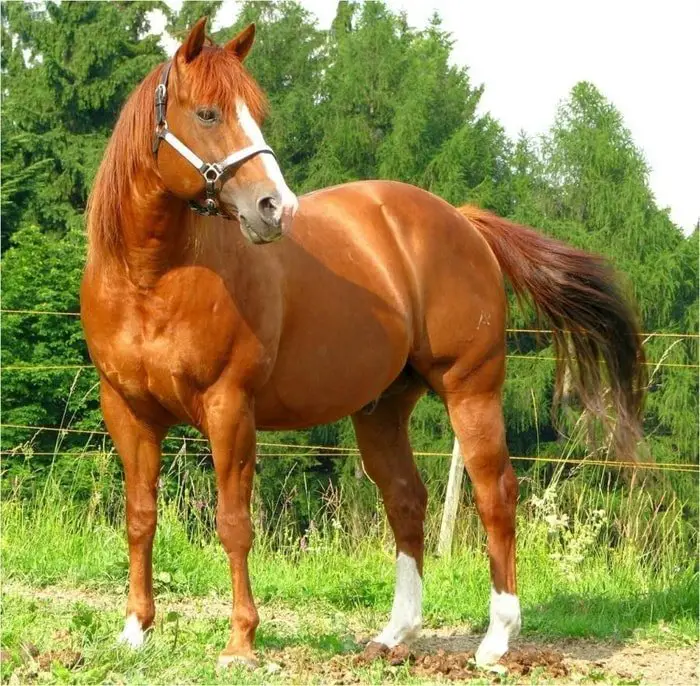The domestication of horse was a pivotal moment in human history that significantly impacted agriculture, transportation, warfare, and trade. It is believed to have occurred around 4000-3500 BCE in the Eurasian steppe, although the exact timeline and location of horse domestication are still subjects of ongoing research.
What is the Domestication of Horse
The domestication of horses was a crucial milestone in human history, transforming how people lived, worked, and interacted. Horses have left a lasting legacy on cultures, economies, and societies worldwide.
- Origins and Wild Horses: Equus ferus originally lived in the wild, roaming parts of Eurasia and North America. The wild horse, often called the tarpan or Przewalski’s horse, is a distant relative of today’s domesticated horses.
- Domestication Process: The domestication of horses involved selective breeding and taming wild horses. It is believed that early human societies in the Eurasian steppe region (primarily areas now part of Ukraine and Kazakhstan) played a significant role in this process.
- Role in Early Societies: Horses quickly became invaluable to human societies once domesticated. They were used for various purposes, such as:
- Transportation: Horses provided a faster and more efficient means of travel than walking or using other animals.
- Agriculture: Horses were used for plowing fields and pulling heavy loads, significantly improving agricultural productivity.
- Warfare: Horses revolutionized warfare by enabling mounted warriors, such as cavalry, to cover large distances quickly and gain a significant advantage in battles.
- Trade: The increased mobility offered by horses facilitated trade between distant regions and cultures.
- Spread of Domesticated Horses: The knowledge of horse domestication gradually spread from its origins in the Eurasian steppe to other parts of the world. Horses played a crucial role in the spread of cultures and technologies.
- Breeds and Varieties: Over time, humans selectively bred horses for various purposes, leading to the development of different horse breeds, each adapted to specific tasks or environments. Examples include the Arabian horse, known for its endurance, and the Clydesdale, bred for heavy work.
- Horses in Mythology and Culture: Horses have been significant in mythology and culture worldwide. They are often associated with symbols of power, beauty, and freedom in various mythologies and belief systems.
- Decline and Modern Use: With the advent of motorized vehicles, the role of horses in transportation and agriculture declined in the 20th century. However, horses continue to be valued for recreational purposes, sports (e.g., horse racing, show jumping), and therapy (e.g., equine-assisted therapy). They are also essential in some remote and rugged regions where modern vehicles are impractical.
History and Origin of Horses
The history of the domestication of horses is a complex and fascinating journey that spans thousands of years. While the exact details have yet to be fully known, archaeology, genetics, and historical records have provided insights into this process. Here is a brief overview of the history of horse domestication:
- Wild Horse Ancestors: The ancestors of modern horses are believed to have evolved in North America around 55 million years ago. These early horse species, such as Eohippus and Mesohippus, were small and adapted to forested environments.
- Migration to Eurasia: Horses migrated from North America to Eurasia over millions of years via the Bering Land Bridge. In Eurasia, they adapted to various environments, leading to the development of different subspecies.
- Horse Domestication in Eurasia:
- Timing: The domestication of horses in Eurasia likely began around 4000-3500 BCE, although the exact timeline remains debatable.
- Location: The domestication process is believed to have occurred primarily in the Eurasian steppe, which stretches across modern-day Ukraine, Kazakhstan, and Russia. This region provided an ideal environment for early horse farming due to its vast grasslands.
- Early Uses:
- Transportation: One of the primary motivations for horse domestication was their use as a means of transportation. Domesticated horses allowed humans to cover long distances more quickly and efficiently.
- Agriculture: Horses were also employed, pulling plows and carts revolutionizing farming methods.
- Warfare: The use of horses in warfare, mainly as mounted cavalry, was a significant development that changed the course of history.
- Spread of Domesticated Horses:
- As human populations expanded and societies traded with one another, horse domestication and breeding knowledge spread to different regions of the world.
- Horses played a crucial role in the success of empires like the Mongol Empire, which relied heavily on mounted cavalry for their conquests.
- Breed Development:
- Over time, various horse breeds were developed to suit specific purposes and environments. For example, Arabian horses were bred for endurance, while draft breeds like the Percheron were bred for heavy labor.
- Industrial Revolution and Decline: The development of steam engines and later motorized vehicles in the 19th and 20th centuries led to a decline in the use of horses for transportation and agriculture in industrialized nations. However, they remained important in rural and agricultural areas and played significant roles in sports, recreation, and cultural activities.
- Modern Uses: Today, horses are primarily used for sports, recreation, therapy, and tourism. They are still integral to some cultures and are often associated with equestrian events like horse racing, show jumping, and rodeo.
Methods of Domestication of Horses
The domestication of horses was a gradual process that took place over many generations and centuries. It involved several methods and strategies employed by early humans to transform wild horses into domesticated animals. Here are some of the critical methods of domestication:
- Selective Breeding: One of the most fundamental domestication methods is selective breeding. Early humans likely recognized certain traits in wild horses that made them more suitable for specific tasks, such as strength for pulling loads or speed for transportation. They would have selectively bred horses that exhibited these desired traits, gradually enhancing them.
- Taming and Training: Taming and training wild horses were crucial to domestication. This involved building trust and a cooperative relationship between humans and horses. Ancient horse trainers and trainers would have used various techniques, including patience, positive reinforcement, and gentle handling, to make horses more manageable and obedient.
- Captivity and Herding: Early humans likely captured and kept wild horses in captivity. This would have involved the construction of enclosures or pens to contain and manage the horses. Over time, these captive horses would have become more accustomed to human presence and control.
- Selective Feeding: Domestication often involves changes in diet. Early horse domesticators may have provided horses with food, such as grains and other cultivated plants, which would not have been readily available in the wild. This would have encouraged horses to remain near settlements and rely on humans for sustenance.
- Socialization: Horses are social animals, and their domestication process may have involved socializing them with other domesticated animals and humans. This interaction would have helped them become more accustomed to living in human-dominated environments.
- Use in Specific Tasks: As humans began to use horses for various tasks like transportation, agriculture, and warfare, horses that performed well in these roles would have been favored for breeding. This practice accelerated the development of specialized horse breeds for specific purposes.
- Genetic Selection: Over time, humans unknowingly select certain genetic traits in horses through breeding. This led to the emergence of specific breeds tailored to meet particular needs. For example, Arabian horses were prized for their endurance, while draft horses were bred for strength.
- Cultural Exchange: As knowledge of horse domestication spread among different cultures and regions, diverse methods and techniques were exchanged and incorporated into the process. This contributed to the developing of a wide range of horse breeds with varying characteristics.
- Inheritance of Knowledge: The methods and techniques of horse domestication were likely passed down through generations, allowing for continuous improvement in the breeding and management of horses.
Domestication of Horse: Types of Horse Breeds
Hundreds of horse breeds are worldwide, each with unique characteristics and attributes. These breeds have been developed over centuries for specific purposes, such as work, sports, or cultural significance. Here are some of the most well-known and widely recognized horse breeds, categorized by their primary use and characteristics:
1. Light Horse Breeds:
a. Arabian: Known for their endurance, Arabians are one of the oldest and most influential horse breeds. They are often used in endurance riding and as the foundation for many other horse breeds.
b. Thoroughbred: Thoroughbreds are famous for their speed and agility. They are primarily used in horse racing but also excel in show jumping and eventing.
c. Quarter Horse: Renowned for their speed over short distances and strength, Quarter Horses are commonly used in Western riding disciplines, including rodeo events, ranch work, and barrel racing.
D. Appaloosa: Appaloosas are known for their distinctive coat patterns, with spots and speckles. They are versatile horses used in various riding disciplines.
2. Draft Horse Breeds:
a. Clydesdale: Clydesdales are large, powerful draft horses known for their strength and distinctive white feathering on their lower legs. They are often used for heavy farm work and in parades.
b. Percheron: These draft horses are solid and versatile, used in farming, logging, and other heavy-duty tasks.
c. Shire: Shires are among the most prominent horse breeds in the world, with a gentle disposition. They were historically used for pulling heavy loads and in agriculture.
3. Pony Breeds:
a. Shetland Pony: Shetlands are miniature, hardy ponies known for their strength relative to their size. They are often used as children’s mounts.
b. Welsh Pony and Cob: Welsh ponies and cobs come in various sizes and are versatile, being used for riding, driving, and even light draft work.
c. Pony of the Americas (POA): POAs are known for their distinctive leopard-spotted coat patterns. They are versatile ponies used in various riding disciplines.
4. Warmblood Breeds:
a. Dutch Warmblood: Dutch Warmbloods are known for their athleticism and are commonly used in show jumping, dressage, and eventing.
b. Hanoverian: Hanoverians are highly regarded for their dressage and show jumping excellence.
c. Oldenburg: Oldenburgs are known for their versatility and are used in various equestrian disciplines.
5. Gaited Horse Breeds:
a. Tennessee Walking Horse: Known for their smooth gaits, Tennessee Walking Horses are often used for pleasure riding and show competitions.
b. American Saddlebred: Saddlebreds are known for their high-stepping gaits and are commonly used in saddle seat riding.
6. Unique and Exotic Breeds:
a. Friesian: Friesians are known for their black coats, luxurious manes and tails, and graceful movements. They are often used in dressage and carriage driving.
b. Akhal-Teke: Akhal-Tekes are known for their metallic sheen, endurance, and speed. They originate from Turkmenistan and are used in various equestrian disciplines.
c. Icelandic Horse: Icelandic horses are known for their five distinct gaits, including the tolt and flying pace. They are used for riding and driving in Iceland and around the world.
These are just a few examples of horse breeds, and there are many more with their unique characteristics and histories. The choice of a horse breed depends on the intended purpose, such as riding, driving, sports, or cultural traditions. Each breed has strengths, and attributes that make it suitable for specific roles and activities.
Final Talk on Domestication of Horse
The domestication of horses stands as a testament to human ingenuity and adaptability. It reshaped history, facilitating the spread of cultures, trade, and technology. Even in the modern era, horses hold a special place in our hearts, reminding us of a shared history spanning thousands of years.

